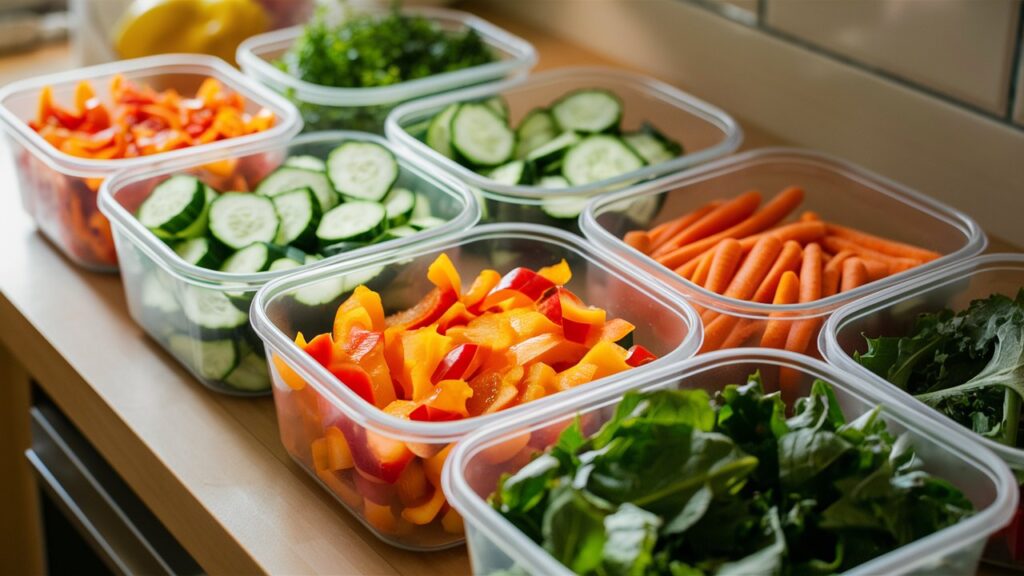7 Ways to Eat More Vegetables: A Guide to Better Health for Women

Eating more vegetables is crucial for maintaining overall health, especially for women. Vegetables are packed with essential nutrients, vitamins, and minerals that support various bodily functions, including hormonal balance. For women, a diet rich in vegetables can help manage menstrual health, improve energy levels, and support overall well-being. In this post, we’ll explore seven effective ways to incorporate more vegetables into your diet and discuss why it’s so important for women’s health. PERIODLY Feel Your Best by Harmonizing Nutrition with Your Menstrual Cycle Why Eating Vegetables is Important for Women’s Health Vegetables are a cornerstone of a healthy diet. They provide a wide range of nutrients that are essential for maintaining good health. For women, in particular, vegetables play a significant role in: 1. Incorporate Vegetables into Every Meal One of the easiest ways to eat more vegetables is to include them in every meal. Here are some ideas: 2. Snack on Vegetables Replace unhealthy snacks with vegetable-based options. Here are some ideas: 3. Try New Recipes Experimenting with new recipes can make eating vegetables more exciting. Here are some ideas: 4. Use Vegetables as Substitutes You can use vegetables as substitutes for other ingredients to increase your intake. Here are some ideas: 5. Add Vegetables to Sauces and Dips Incorporate vegetables into sauces and dips to boost their nutritional value. Here are some ideas: 6. Grow Your Own Vegetables Growing your own vegetables can be a rewarding way to increase your intake. Here are some tips: 7. Plan Your Meals Planning your meals in advance can help ensure you include plenty of vegetables. Here are some tips: The Connection Between Vegetables and Hormonal Health For women, hormonal health is a critical aspect of overall well-being. Hormones regulate many bodily functions, including metabolism, mood, and reproductive health. Eating a diet rich in vegetables can support hormonal balance in several ways: Incorporating more vegetables into your diet is a simple yet powerful way to improve your health, especially for women. By following these seven tips, you can enjoy the benefits of a vegetable-rich diet, including better hormonal balance, improved digestion, and reduced risk of chronic diseases. Are you ready to take control of your health and synchronize your menstrual cycle with your nutrition? Join our waiting list for our upcoming product designed to help you achieve optimal health and well-being.
Craving Control: Smart Snack Choices During Your Cycle

Did you know that women often feel up to 150 strong cravings during their menstrual cycle? These cravings can make it hard to stick to a healthy diet. But, with the right tips, you can handle these cravings and stay healthy during your cycle. PERIODLY HELPS TO FEEL BETTER BY ALIGNING NUTRITION WITH MENSTRUAL CYCLE Key Takeaways Understanding Menstrual Cravings The menstrual cycle is complex, involving hormones like estrogen and progesterone. These hormones affect our cravings and eating habits. During the premenstrual syndrome (PMS) phase, hormone changes cause emotional and physical symptoms. This includes food cravings that are hard to control. Hormonal Fluctuations: The Driving Force Changes in estrogen and progesterone levels affect the brain’s chemicals. These chemicals, like serotonin and dopamine, control our mood and hunger. This imbalance can make us crave more sugar and chocolate. It’s our body’s way of trying to feel better during PMS. PMS and Emotional Eating In the premenstrual phase, emotional and physical changes can lead to emotional eating. People might eat comfort foods to feel better. This hormonal imbalance makes it hard to stop these cravings. It can lead to weight gain and health issues. Knowing how hormonal changes affect our menstrual cravings helps us manage them. It’s key to a balanced diet during the menstrual cycle. Navigating Sugar Cravings Sugar cravings, especially for chocolate, are common during the menstrual cycle. They often happen because serotonin levels drop. Serotonin helps control mood and hunger. Hormonal changes during the cycle make us want sugar and chocolate, leading to emotional eating. The Science Behind Sugar Cravings Low serotonin levels make us crave foods that boost serotonin, like sugary snacks. These foods can make us feel better for a little while. But, this can start a cycle of changing blood sugar and hormone levels, making us crave more. Hormonal imbalance also affects sugar cravings. In the premenstrual phase, changes in estrogen and progesterone levels make us eat more emotionally. These hormones change how we feel hunger and fullness, and how we handle stress and anxiety. Factors Influencing Sugar Cravings Impact on Cravings Serotonin Levels Decreased serotonin levels can lead to a craving for mood-boosting, sugary foods. Hormonal Fluctuations Changes in estrogen and progesterone can contribute to emotional eating and a desire for sweet treats. Blood Sugar Levels Fluctuations in blood sugar can trigger cravings for quick energy sources, like sugar and carbohydrates. Understanding why we crave sugar and chocolate helps us manage these cravings better. By eating mindfully, keeping blood sugar levels stable, and finding other ways to boost serotonin levels, we can eat healthier during the menstrual cycle. Food Cravings: Decoding Your Body’s Signals During your menstrual cycle, food cravings might seem like just a whim. But they could be your body’s way of telling you something. They might signal a need for certain nutrients or energy sources. Knowing what causes these cravings can help you make better food choices for your health. Craving salty foods like chips or pretzels might mean your body needs electrolytes. These are lost during menstruation. On the other hand, carb cravings could be because your blood sugar levels are changing. Your body is looking for a quick energy boost. Sweet cravings might be related to hormonal changes or a need for serotonin. This is a chemical that helps improve your mood. By paying attention to these cravings, you can adjust your diet to meet your body’s needs. This can ease discomfort, boost your mood, and give you the energy and nutrients you need. Craving Potential Cause Healthier Alternatives Salty foods Electrolyte depletion Nuts, seeds, avocado, leafy greens Carbohydrates Blood sugar fluctuations Whole grains, sweet potatoes, oats Sweets Hormonal imbalance, serotonin deficiency Dark chocolate, Greek yogurt, fruit Understanding your food cravings can help you make better food choices during your menstrual cycle. This can ease discomfort, improve your mood, and give you the energy and nutrients you need. “Listening to your body’s cravings can be a powerful way to support your overall health and well-being during your menstrual cycle.” Healthy Snack Alternatives Fueling your body with nutrient-dense options can satisfy your cravings and boost your health. Discover healthy healthy snacks that make managing your menstrual cycle easier. Enjoy fresh fruits, crunchy vegetables, and whole grain snacks for a guilt-free treat. Nutrient-Dense Options Choose snacks full of vitamins, minerals, and fiber to support your menstruation diet. Try Greek yogurt with berries, hummus with carrot sticks, or mixed nuts for a satisfying snack. These nutrient-dense snacks help control cravings and nourish your body during your cycle. Satisfying Your Sweet Tooth You don’t have to give up on comfort food to stay healthy. Satisfy your cravings with natural sweetness from fruits, dark chocolate-dipped strawberries, or homemade energy bites. These healthy snack choices let you enjoy treats while supporting your health during your menstrual cycle. FAQ What causes menstrual cravings? Hormonal changes, like those in estrogen and progesterone, can affect your mood and appetite. This can lead to emotional eating during the premenstrual phase. People might eat comfort foods to feel better. Why do I crave sugar and chocolate during my period? Sugar cravings, especially for chocolate, are common during your cycle. This happens because serotonin levels drop, making you feel moody. You might want foods that lift your mood. What is my body trying to tell me when I have specific food cravings? Cravings can signal your body needs certain nutrients or energy. For instance, wanting salty foods might mean you need electrolytes. Cravings for carbs could be due to changing blood sugar levels. Paying attention to these clues can help you make better food choices during your cycle. What are some healthy snack alternatives to satisfy my cravings? Healthy snacks can help you satisfy cravings and support your body. Try adding more fruits, veggies, and whole grains to your diet. Also, choose healthier sweets to curb cravings during your period. How can I manage my period cravings in a healthy way? Here are ways to handle cravings healthily: – Figure out why you’re craving, like hormonal shifts or emotional eating – Eat nutrient-rich foods to meet your body’s needs – Pick healthier options for sweet or salty cravings, like dark chocolate or nuts – Drink plenty of water and eat a balanced diet for overall health – Practice self-care to reduce stress and improve your mood during your cycle.